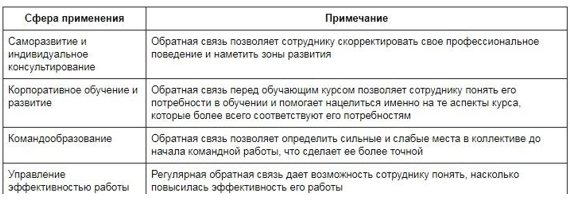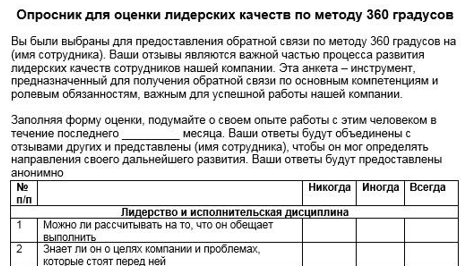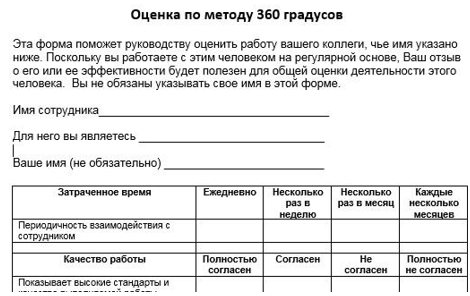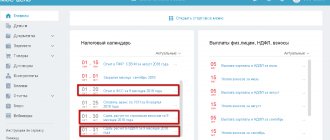Would you like to form an opinion about the current level of competence and effectiveness of a particular employee through the prism of perception of his colleagues, subordinates, supervisor and other people around him? Get answers, for example, to the following questions: “Are management skills used effectively?”, “How productive are relationships with the team?”, “Who is the leader and who is the outsider, whose authority is indisputable, who is listened to, and who is ignored don’t put it and ignore it?” These and many other questions can be answered by conducting a 360-degree assessment of a particular category of employee.
What is the 360 degree method?
Typically, an employee receives feedback and assessment of his professional competencies from his immediate supervisor.
The 360-degree assessment method is used to obtain confidential, anonymous feedback from people who interact with the employee in the process of work. Respondents asked to complete a 360-degree questionnaire to rate an employee's competencies include:
- direct and line manager;
- colleagues, including those he manages;
- customers, suppliers, clients, etc.
The employee being assessed also takes part in the survey. This is necessary to compare the rating given in the self-survey and the one received as a result of feedback. This is important because employees with average performance tend to overestimate their competencies, while those who work productively, on the contrary, underestimate their competencies, since they are characterized by perfectionism and self-demanding behavior.
360 degree assessment is called this because a person’s professionalism and personal qualities are assessed by different people with different statuses. The number of survey participants can range from 4 to 15 people. These are the people who communicate with the subject of the survey most often during their work. Before distributing questionnaires to them, you should make sure that their attitude towards the object of the questionnaire is unbiased.
Definition of evaluation criteria
Evaluation criteria are divided into two types:
- Skills: Integrated use of knowledge, skills, and attitudes to perform tasks with maximum efficiency.
- Results: objective numbers and data that demonstrate that the owner of these skills is effective in delivering the results the company requires.
The idea is to determine which employees are the most efficient and productive for the company, and which ones need training or mentoring.
The ultimate goal is to develop an action plan so that each employee can improve their weaknesses and make the most of their strengths.
To decide whether to implement this method to evaluate your employees, you need to know its advantages and disadvantages.
When to use 360 degree personnel assessment
This assessment method can be used either independently or in addition to other assessment methods. See the table for areas of application.

The 360 degree assessment system is used for leaders and managers who want to understand and evaluate their strengths and weaknesses. Based on the survey results, development plans are drawn up.
The 360 degree method is also used to evaluate personnel who do not belong to the category of managers. In these cases, feedback allows line staff to improve their performance in their current roles. Employees gain insight into what competencies they need to develop to ensure career growth. HR Director magazine experts will give you tips on how to increase the relevance and objectivity of assessments when using the 360 degree method
Two Ways to Use the 360 Degree Evaluation Method
Companies use the 360 degree method in one of two ways:
- As a development tool that helps a person identify strengths and weaknesses based on the results of anonymous feedback, which is usually inconvenient to give to colleagues. The recipient of the feedback gains insight into how others perceive him and has the ability to adjust behavior and develop skills that will enable him to excel at his job.
- As a performance appraisal tool to measure employee performance. In this case, a 360 degree test is not always a good idea because the feedback focuses on behavior and competencies more than basic skills, job requirements, and performance goals.
Note! If you use the 360-degree method to evaluate employee performance, include it in the overall system of methods for assessing and improving employee performance, along with those tools that allow you to obtain a quantitative assessment.
Why it is advisable to use a 360 degree assessment:
| It is advisable | Not advisable |
| Assessment of behavior and competencies | Performance measurement |
| Gaining insight into how colleagues, subordinates and managers perceive you | Determining Compliance with Professional Competence |
| Assessment of skills such as listening, planning and goal setting | Assessing an employee’s compliance with the basic requirements for the position |
| Focus on subjective characteristics such as teamwork, communication, character, and effectiveness as a leader | Measuring strictly objective things such as traffic, sales quotas, etc. |
Please note that the 360-degree assessment system is ineffective in companies that use a commanding, authoritarian management style. In such cases, management, as a rule, distances itself from subordinates and does not enjoy special trust from the team; there is no tradition of collective cooperation and assistance.
On a note. HR professionals need to know how employees who are offended by their immediate supervisor can express their dissatisfaction. What surprises can you present? You need to know this in order to think in advance how to prevent such situations. An expert from HR Director magazine found several live examples from online forums
Pros of the 360 degree assessment method:
- allows you to evaluate the contribution and effectiveness of each individual employee;
- makes it possible to identify weaknesses and “growth points” for employees and the team as a whole;
- does not require serious financial costs, can be carried out by the HR department (as opposed to the same assessment center, which involves the work of a team of external experts);
- if the survey is conducted online, the method allows you to cover a large number of employees;
- allows you to evaluate the so-called soft skills, skills of interaction with others.
360 degree assessment: principles and rules
The main principle on which the 360-degree assessment and methodology is based is strict adherence to the anonymity of respondents, if, of course, they want to maintain it.
A 360-degree assessment will only produce the desired results if the team does not use surveys as a tool to settle scores with each other. Use the 360 degree method very carefully, making sure that there are no problems in the team and anonymity will not become a reason to “bury” a more successful colleague.
360 degree assessment, the methodology for its implementation requires special training. Follow a step-by-step approach to preparing and conducting assessment activities. The HR System expert will give useful advice on how to properly prepare and organize a personnel assessment using the 360-degree method
Four stages of conducting a 360 degree personnel assessment
Stage 1. Explanation and training
If you give the 360 Degree Assessment to an untrained respondent, you may get irrelevant results. Prepare survey participants for the assessment by telling them the purpose and rules for conducting the assessment. Explain why the assessment is needed and how its results will be used. Respondents must understand the importance of assessment and perceive it as a tool for professional improvement, a means of achieving the common goals of the company and employees.
Stage 2. Questioning using the 360 degree method
Distribute questionnaires and ask respondents to complete them by a certain deadline. If there are many participants and the questionnaires are lengthy, automate the processing of results using online platforms such as SurveyMonkey, Google Forms or MindMiners.
Stage 3. Processing and analysis of 360-degree personnel assessment results
After tabulation or analysis using online search tools, share the results obtained only with the interested party and the employee’s immediate supervisor. None of the employees should know how one of their colleagues rated him. The survey subject only has access to general data and statistical results.
Stage 4. Feedback and development plan
This is the ultimate goal of applying the 360 degree assessment method. Together with the employee, draw up a development plan and coordinate it with the immediate supervisor. An expert from Sistema Personnel will tell you how to properly conduct a 360-degree assessment of a company, how to draw up a plan and process the results
Stages of employee assessment using the 360 degree method
The 360 degree assessment method consists of several steps:
- Preparatory part. Formation or selection of a questionnaire, selection of the employee’s environment that will participate in the survey.
- Introductory part: conversation with event participants to explain the goals and methodology of the survey.
- Interviewing participants, summing up results and preparing reporting documentation.
- Feedback to employees who participated in the event.
Particular attention should be paid to the feedback stage, involving an experienced expert in this process in order to avoid annoying mistakes and carry it out as efficiently as possible.
360 degree assessment: 3 ready-made questionnaires
When developing questionnaires yourself, consider what exactly you want to assess. When it comes to professional competencies, include no more than 50 items in the questionnaire. Choose exactly those that correspond to your goal.
Don't complicate the questions, but also decipher them so that the respondent understands what exactly is meant. For example, when you want to assess stress resistance, write in the questionnaire: “Maintains smooth, calm relationships with clients, does not react to rudeness.”
Decide which rating scale you will use. If you use a 360-degree numerical competency rating scale, do not make it a five-point scale so that a rating of 1 or 2 is not perceived as a negative indicator. It is better to use letter, neutral symbols or increase the number of possible points to 8-10.
Questionnaire No. 1. 360 degree assessment example of a questionnaire on professional competencies

Experts at Sistema Personnel offer another version of the questionnaire that allows you to assess the professional competencies of an employee
In the case when the 360 degree method is used to assess the leadership qualities of staff, the questionnaire will be much shorter, limit yourself to 10-15 positions, this is enough to get an idea of the presence or absence of leadership inclinations in the employee. To evaluate in this case, use the concepts “Never”, “Sometimes”, “Always”.
Questionnaire No. 2. 360 degree method example of a questionnaire about leadership qualities

By setting a probationary period for a new employee, the company's management wants to make sure that he really has the personal qualities that will be in demand. For newcomers completing the adaptation period, you can use a shortened version of the 360-degree assessment questionnaire.
Questionnaire No. 3. 360 degree questionnaire for assessing a new employee undergoing a probationary period

conclusions
Use the 360 degree method for personnel assessment as a development tool. Use it carefully, making sure employees don't use it to settle scores.
In what cases can the 360 degree method be used?
- If you need to understand which employees can be promoted up the career ladder. This is especially true for large companies with an extensive network of branches, where the HR department does not have the ability to track the progress of each employee. A 360 survey will help you quickly identify those who deserve a promotion.
- If you need to plan your training. When there is an understanding that employees lack knowledge, but there is no clarity about who and what specifically, a 360 assessment will be very helpful.
- If you need to evaluate the managerial qualities of managers. Since subordinates participate in the evaluation, reliable data can be obtained about what they think of their supervisor. Provided, of course, that anonymity is maintained.
- If you need to generate feedback for an employee. Thanks to an assessment from all sides, the manager can voice not only his personal opinion, but also share information received from other participants in the assessment - of course, without naming names.
- If you need to evaluate not quantitative indicators, but so-called soft skills. There is no adequate replacement for this term in Russian. This is a set of qualities that allow you to interact with others - communication skills, the ability to listen and hear, initiative, etc.
360 degree assessment: sample questionnaire
One of the common barriers to human development is the inability to look at oneself from the outside. Is it possible to effectively build a career and position yourself correctly if you don’t understand how your colleagues and managers see you? One of the best methods in global management and HR practice that allows you to solve these problems is employee assessment using the “360 degree” method.
The “360 degree” method is called so precisely because it allows you to evaluate an employee from all sides, “in a circle.” Ideally, the list of evaluators looks like this:
- the employee himself, who grades himself according to given criteria;
- immediate superior;
- colleagues or other managers;
- subordinates (if any);
- in some cases, clients who communicate with the appraisee.
The number of questions and the time it takes to fill out questionnaires are significant factors in the success of the method. If there are too many questions (more than 50) or they are difficult to understand, there is a risk of a formal attitude towards the procedure, people will get tired of answering, which will lead to a decrease in the reliability of the results. Let's take a closer look at compiling the questionnaire.
Advantages of the 360 degree method
- Feedback about an employee from various sources
This method provides comprehensive feedback from peers, employees, managers and supervisors, and is undoubtedly better than feedback from one person. It also saves managers time because they can spend less energy on their feedback as more people are involved in the process. Peer perceptions are important, and this process helps people understand how other employees view their work.
- Develops and strengthens teamwork and responsibility
This approach helps team members learn to work together more effectively. Employees know more about how team members work than their manager. Feedback from multiple peers makes team members more accountable to each other as they share knowledge that they will contribute to each member's performance. A well-planned process can improve communication and team development.
- Identify problems, improve personal and organizational results
The 360 degree method is one of the best methods for understanding personal development needs and company growth needs. You can learn what prevents employees from working together successfully and how your organization's policies, procedures, and approaches impact employee success.
Many companies that use the 360-degree method to evaluate employees focus on identifying strengths. This makes sense to improve staff efficiency.
- Identifies specific areas for career development
For many reasons, organizations do not take responsibility for the career development of their employees. While most of the responsibility falls on the employee, employers have a responsibility to create an environment where employees are motivated and supported in their growth and development. Feedback from several colleagues can provide an individual with information about what he or she needs to do to improve his or her career.
In addition, many employees find this feedback to be more accurate, better reflective of their performance, and more trustworthy than feedback from a single manager who rarely sees their work. This makes the information more useful for both career and personal development.
- Reduces the risk of bias and discrimination
When feedback comes from a range of people with different job responsibilities, the potential for discrimination based on age, gender or other characteristics is reduced. The effect of a manager judging an employee's performance based on their most recent interactions with them is also minimized.
OPEN AN ONLINE SCHOOL ON THE ANTI-TRAINING PLATFORM
- Improves customer service
Each person receives valuable feedback on the quality of their product or services, especially in surveys in which the customer participates. This feedback should enable the employee to improve the quality, reliability and responsiveness of the products and services he provides.
- Training needs assessment
The 360 degree method provides comprehensive information about the training needs of employees and thus allows for training planning, online training and cross-training.
Statement questions
The correct formulation of question-statements is of great importance (the questionnaire may also consist of closed questions, although statements quite often represent a more universal and convenient form). They should cover the core competencies that are intended to be assessed. The more quality a company needs, the more questions about it should be included in the questionnaire. It is important that they are clear and do not use complex or ambiguous terms.
An example of an unsuccessful question-statement: “Tolerant of the characteristics of other people” - not all respondents may know this term. Another example: “In conflict, I am prone to compromise solutions.” The answer depends on how one understands the compromise strategy. Perhaps he perceives it on an everyday level as a desire to meet others halfway or considers it not the most successful because he prefers cooperation (especially if he has successfully completed conflict management training). As a result, the assessment will not be entirely reliable.
When composing questions-statements, in most cases, you should not use formulations that suggest extremes in answers (“always manifests itself,” “never manifests itself”), since then they cannot be simultaneously honest, objective and unambiguous. For example:
- “Never criticizes management decisions and strategies in any form;
- “Always takes initiative and makes rationalization proposals”;
- “Never gets irritated or shows negative emotions.”
Thus, when formulating statement questions, it is recommended to adhere to the following rules:
- avoid complex terms and ambiguity;
- use words that everyone understands;
- avoid extremes (the exception is checking the sincerity and objectivity of respondents).
360 degree questionnaire to determine the level of Emotional Intelligence
The Emotional Intelligence Assessment was developed to provide a deeper understanding of social, interpersonal, and motivational domains for professional development. Many self-assessment surveys have been created to measure emotional intelligence, but one of the most effective ways to measure it is to collect feedback from others through a 360-degree survey.
A big benefit of assessing emotional intelligence using a 360-degree survey is identifying blind spots when self-esteem differs significantly from the assessment of others. By comparing your assessment with the opinions of others, you can create a more effective development plan, as well as increase your self-awareness. For managers, such an assessment can reveal the reasons for difficult relationships with the team and provide ideas for personal development.
The GoTalent 360 degree questionnaire is built on the basis of a description of behavioral indicators, which can be used to fairly accurately speak about the manifestation of Emotional Intelligence competence.
At the same time, respondents are asked to evaluate the degree of manifestation of each behavioral indicator as an answer to the question about how often this behavior is manifested by the person being assessed on a five-point scale: never, rarely, sometimes, often, always.
EQ assessment using the 360 method means that in addition to you, up to 10 outside observers from your environment should also be tested to assess your EQ. Thanks to such an assessment, the results are guaranteed to be more objective.
The questionnaire contains 46 statements describing behavior that reflects the level of development of emotional intelligence. Statements reflect behavior in 4 elements of emotional intelligence:
ü Self-perception, understanding of one’s emotions
ü Self-management
ü Understanding the emotions of others
ü Relationship management
After filling out the questionnaire, based on the score, you can determine the level of development of emotional intelligence as a whole - the sum of all points, and separately look at the level of development of individual elements of the structure of emotional intelligence.
1. Take the questionnaire yourself first.
2. Let your colleagues fill out the questionnaire and evaluate you
3. Compare the results
| № | Demonstration of competence | Always | Often | Sometimes | Rarely | Never | Comments, examples of real situations |
| 1 | Knows what motivates him and what demotivates him at work | ||||||
| 2 | Expresses suggestions to colleagues on how to behave with him in order to improve interaction | ||||||
| 3 | Remains calm in difficult situations | ||||||
| 4 | Offers options for improving interaction at work: meeting formats, feedback, etc. | ||||||
| 5 | Offers options for improving interaction at work: meeting formats, feedback, etc. | ||||||
| 6 | Offers options for improving interaction at work: meeting formats, feedback, etc. | ||||||
| 7 | Remains open and sincere when communicating | ||||||
| 8 | In particularly difficult situations, he carefully monitors the tone of his speech and makes every effort to ensure that communication remains within the proper framework. | ||||||
| 9 | In some cases, he conveys his tension and irritation to others | ||||||
| 10 | Does not notice irritation, overload of people, anxiety | ||||||
| 11 | Conducts diagnostics of relationships, feelings, emotions, expectations | ||||||
| 12 | Being in an excited state, he talks a lot and sometimes does not allow the interlocutor to insert a word, doing this unconsciously. He just worries too much about what he's doing. | ||||||
| 13 | Loses emotional control in a difficult situation, making erroneous actions | ||||||
| 14 | Maintains patience and understanding even in tense and emotionally charged environments, such as actively listening and giving sound advice | ||||||
| 15 | Deals with difficult situations while maintaining composure | ||||||
| 16 | Copes with situations of tension and confrontation, maintains a cool head | ||||||
| 17 | Despite disappointment, he continues to interact and achieves the most optimal solution. | ||||||
| 18 | Subject to emotional outbursts, has difficulty controlling himself, makes erroneous actions | ||||||
| 19 | Allows emotions to guide one's actions, such as speaking and acting impulsively without thinking things through | ||||||
| 20 | If something upsets you, don’t keep it to yourself, but set the tone for everyone around you with your upset. | ||||||
| 21 | Causes tension among others and has a negative impact on others | ||||||
| 22 | Is jealous of the successes of others | ||||||
| 23 | Shows composure, enthusiasm, inspiration and other emotions exactly when needed | ||||||
| 24 | Builds effective communications with almost any person | ||||||
| 25 | Is attentive to the feelings of others and adapts his communication style in order to reach a resolution of the situation. | ||||||
| 26 | Trying to get to know others better | ||||||
| 27 | First, he listens carefully to his interlocutors, and only then offers them his opinion. | ||||||
| 28 | Shows a genuine interest in understanding other people and offering them valuable insights related to what they are talking or thinking about | ||||||
| 29 | Demonstrates disregard for the ideas and opinions of others through various methods | ||||||
| 30 | Does not pay attention to the specifics of a particular situation, feelings, emotions of others | ||||||
| 31 | A number of non-verbal signs allow other people to understand that their opinion is not interesting, and because of this they lose interest in what is happening | ||||||
| 32 | Constantly trying to assert herself and therefore having difficulty accepting other people's points of view or appreciating their contributions to a task | ||||||
| 33 | When the interlocutor is upset, asks the minimum questions necessary to resolve the situation, and then gives specific advice and provides real help to people, which makes them feel one hundred percent better | ||||||
| 34 | Makes you feel smart and trustworthy even when you make a mistake, helps employees become better, grow | ||||||
| 35 | Difficulty celebrating the successes and achievements of colleagues | ||||||
| 36 | Motivates and inspires people | ||||||
| 37 | Improve the mood of others and alleviate their suffering | ||||||
| 38 | Even during difficult discussions, he takes care to maintain good and comfortable connections with all parties involved in the discussion | ||||||
| 39 | Appreciates the achievements of colleagues and always praises them when they deserve it | ||||||
| 40 | He knows his colleagues well, and this allows him to solve all problems that arise calmly and positively, adequately | ||||||
| 41 | Some decisions are made only on the basis of personal opinion or prejudice, which demotivates others | ||||||
| 42 | Acts stubbornly and without any empathy, especially in relationships with colleagues | ||||||
| 43 | Looks for someone to blame in every situation, which tires and demotivates others | ||||||
| 44 | Makes judgmental or negative statements toward team members or others, especially in situations where such statements are not helpful | ||||||
| 45 | Creates an atmosphere of openness and builds trusting relationships with others to achieve goals | ||||||
| 46 | Creates and organizes moments when you can freely, without risking anything, discuss your innermost feelings with others to achieve goals |
Decoding the results:
Answers to questions: 1, 2, 3, 4, 5, 6, 7, 10, 13,14,15,16, 22, 23, 24, 25, 26, 27, 28, 33, 34, 36, 37, 38, 39, 40, 45, 46
Always scored - 4 points, often - 3 points, sometimes - 2 points, rarely - 1 point, never - 0 points
Answers to questions: 8, 9, 11, 12, 17, 18,19, 20, 21, 29, 30, 31, 32, 35, 42, 43, 44
Always assessed in points - “-4” points, often - “-3” points, sometimes - “-2” points, rarely - “-1” point, never - 2 points
Calculation of results
- Add up the sum of all points – max – 148, min – “-72”
- Add up the sum of points by blocks
Self-perception, understanding your emotions - questions 1 to 12 (max - 40, min - “-16”)
Self-management - questions from 13 to 22 (max - 30, min - “-20”)
Self-perception, understanding the emotions of others - questions 23 to 32 (max - 32, min - “-16”)
Relationship management - questions 33 to 46 (max - 46, min - "-20")
high level of EI 100-148
Able to recognize the mood of the interlocutor, notice his feelings and cope with his own emotional background. Such qualities allow you to establish connections, attract attention, promote trust and, as a result, occupy high positions that involve managing a team. Identifies different emotions of himself and others. Predicts emotional reactions of oneself and others. Consciously manages emotions. Improves the mood of yourself and those around you.
average EI level 50-99
Identifies strong emotions in himself and others. Predicts emotional reactions of oneself and others in simple obvious situations. Unconsciously controls emotions. Can improve the mood of yourself and others in simple situations
low level of EI >50
Poorly identifies the emotions of himself and those around him, therefore he does not predict the emotional reactions of himself and others, does not manage them, and is subject to impulsive emotional outbursts. Emotions control a person, but he does not realize it.
| Interpretation of results | ||
| Total sum of all points | 100-148 | high level of EI |
| 50-99 | average level of EI | |
| >50 | low level of EI | |
| Sum of points by blocks | ||
| Self-perception, understanding your emotions | 30-40 | high level of EI |
| 10-29 | average level of EI | |
| >10 | low level of EI | |
| Managing yourself | 24-30 | high level of EI |
| 10-23 | average level of EI | |
| >10 | low level of EI | |
| Self-perception, understanding the emotions of others | 26-32 | high level of EI |
| 10-26 | average level of EI | |
| >10 | low level of EI | |
| Relationship management | 32-46 | high level of EI |
| 10-32 | average level of EI | |
| >10 | low level of EI |
Ensuring the reliability of responses
Sincerity scale
It is recommended to include several statement questions in the questionnaire that do not involve “extreme” wording of answers. They help determine the sincerity of research participants. For example, it is impossible to give unambiguous polar assessments in the case of the following statements:
- “Does not make mistakes even in small details”;
- “Never partial towards people, always avoids personal likes and dislikes”;
- “Unambiguously positively perceives any decisions of management, etc.”
If the evaluator gives an “extreme” answer to these statement questions, this indicates either his insincerity (usually about inflating ratings with the best intentions, for example, out of sympathy for a colleague), or about a formal approach to the survey.
When such an answer occurs 1-2 times, it is worth reducing the calculated score by 1 unit, but if there are many such options, then this questionnaire must be excluded from the general analysis, since the reliability of the results is in question.
Flip Questions
Some people tend to choose mostly the same answers to evaluate a colleague. Most often, this is not an average assessment option (“appears in about half of the cases”), but a stable choice of answers like “always manifests itself” or “appears in most cases.” By choosing this approach, the employee does not think much about the questions and answers formally. This can be avoided by including questions in the questionnaire, the best answer to which is “Never does.”
It is worth warning employees about the presence of such “shifters”, and this will increase the likelihood of correct answers.
Duplicate questions
These questions allow you to analyze assessments for objectivity and reliability and eliminate those that do not meet these criteria. The point is that two or three questions have different wording, but are absolutely identical in content (it is important that they are not located next to each other). An example of such a take:
- “Able to manage conflicts from a collaborative perspective, i.e. in such a way that all parties benefit as much as possible”;
- “In a conflict, he usually does not try to shift the situation towards his interests.”
There is another type of question of this type - close questions. Not being complete duplicates, they imply a gap in answers of no more than 1 point, otherwise the result is assessed as low confidence.
Decisions based on survey results It is worth considering that assessment using the “360 degree” method is subjective in any case, so it should not be considered as a tool for making administrative decisions - rewards, punishments, promotions, etc. In addition, if employees learn about such consequences of the assessment , then the answers will either be overestimated due to the reluctance to “frame up” colleagues, or underestimated in order to settle scores. In most foreign companies, where this practice originated, the “360 degree” questionnaire serves as a tool for employee self-development or (less often) the subject of joint analysis with his manager.
Based on the assessment results, it is necessary to identify the following areas:
A - inflated self-esteem compared to the assessment of others;
B - low self-esteem compared to the assessment of others;
B - high and low ratings;
D - differences in the assessment of the same competencies among assessors of different levels.
In cases A and B, you should find out from colleagues and managers the reason for the discrepancies. The likely conclusion is that a person cannot see himself from the outside. He should definitely initiate receiving feedback from others more often, compare his own behavior and those of those people who are considered as a standard, i.e., have competencies that are significant for the company. Situation B gives the most complete picture of the employee's strengths and weaknesses. The big plus in this case is that a person can see himself from the outside, understand how others react to him.
Section D is very important for analysis by both the person being assessed and his supervisor. It is worth clearly identifying the reason for the discrepancies and adjusting your behavior during communication at those levels to which employees who gave low ratings belong. A manager, if his opinion differs significantly from the ratings given by peers or subordinates, needs to be more attentive to the employee’s behavior: focus on the merits (if the boss’s rating was lower than others) or learn to identify socially desirable behavior (if the rating is higher).
Let us give an example of a questionnaire that was used in one of the companies (it should not be considered as universal, suitable for any organization). Try checking yourself and highlighting:
- competencies that are tested by this questionnaire;
- questions related to the sincerity scale;
- flip questions;
- questions (there may be 2 or more of them), the discrepancy in answers to which should not be more than 1 point (example of duplicate questions).
Questionnaire using the “360 degree” method (example)
Instructions for survey participants Dear employee! This survey will help your colleague (the person being assessed) better understand their strengths and weaknesses, and see the potential for further growth and development. No incentives or penalties will be taken based on the results of the study. We guarantee anonymity and confidentiality. In this regard, we ask you to provide as truthful, frank and thoughtful answers as possible. If, based on the nature of your interaction with this person, you do not see the manifestation of certain aspects of behavior and cannot judge how he manifests himself in the situations described, please select the answer: “I have no information.” In addition, some questions suggest the best answer is “Always shows”, and some - “Never shows”. Be careful! There are also several questions, the answers to which will allow us to assess the reliability of the result; in case of low reliability, the questionnaire will have to be filled out again, which is undesirable. The survey takes on average 30 to 45 minutes. We recommend that you fill out the questionnaire immediately from beginning to end, without being distracted. This way you can save time and increase the reliability of the results. You can provide significant assistance to a colleague in understanding his strengths and weaknesses and planning for further development and growth. Thank you for your sincere answers!
What you need for a 360 assessment
Firstly, you need a “ruler” - that is, a model of competencies by which you will conduct the assessment. A competency model is a set of qualities that we need in an employee. For example, a sales specialist must be a communicator, be able to listen, be able to make decisions quickly, etc. The secretary must be attentive to details, be able to keep several tasks in mind at the same time and not forget anything, and, of course, be friendly and polite with visitors.
Secondly, as we already mentioned, the 360 assessment method can be quite a stressful undertaking. Therefore, it is critical to communicate to all participants what the assessment is for. It is necessary to show what is the same as in school - “Ivanov, come to the blackboard!” Do not you know? Two!" - will not be. On the contrary, based on the results of the assessment, the employee will have the opportunity to look at his work through someone else’s eyes and see areas for development. By the way, the management will receive the same thing.
Thirdly, you need to prepare the actual questions and answer options. We will dwell on this point in more detail.
The essence of the method
The term "360 degree assessment method" was coined by Ward in 1987. Ward defined this method as the systematic collection of information regarding the results of an individual or group, obtained from the environment."
The 360 degree technique began to be actively used in the West in the 1990s. In the early 2000s, Russian HR specialists began to adopt this experience from their Western colleagues, and now this method is a popular means of personnel assessment in Russia.
The essence of the “360 degree” methodology is that an employee is assessed by his entire work environment: managers, subordinates, colleagues and clients. The result of the assessment is a rating of the employee’s properties (the measure of compliance with the position held is assessed according to the list of competencies). Also, thanks to the self-assessment block, this method can be used as a source of feedback. An employee is assessed using the 360-degree method by surveying his environment: boss, colleagues, subordinates. If other stakeholders (consumers, clients, suppliers, partners) join the assessment, then the 360 method is transformed into a 540 degree method.
Appraisers assign scores for competencies in special questionnaires; the survey can be conducted anonymously, indicating the category of the appraiser (colleague, manager, client) or not anonymously. Then the arithmetic average for each competency is calculated and a competency graph is built. At the last stage, the assessment results are presented to the employee being assessed. As a result of the assessment using the 360-degree method, conclusions can be drawn for the employee’s self-development, for developing competencies, improving relationships with colleagues, and decisions can be made on training, inclusion in the personnel reserve list, etc. Decisions on improving the employee’s qualifications, promotion/demotion and other personnel decisions cannot be made based on a 360 assessment; there is an attestation procedure for this.
Advantages of the method
The advantages of the 360 degree assessment method are as follows:
- The ability to objectively evaluate an employee, considering the opinions of several participants in the process.
- Financial benefit: the ability to conduct a survey through the efforts of internal employees.
- Equality of participants: in the survey, not only the manager “paints” a professional portrait of the subordinate, but also the subordinate expresses his position regarding the work of the manager.
- Anonymity of participants: employees maintain anonymity, which allows them to freely express opinions.
Limitations of the method:
- Cannot be used for changes in an employee’s work such as transfer, increase in income, dismissal.
- When applying the method, we are talking about the employee’s competencies, not including his successful results.
- Only the signs that are relevant at the moment are assessed, without foreseeing the further development of the situation.
- The impact of an employee’s self-assessment on the outcome of the survey (if self-assessment is overestimated or underestimated, the survey data may not be 100% reliable).
To reduce the impact of the weaknesses of the methodology, it is recommended to combine “360 degrees” with methods such as conducting assessment centers, interviews, observation, passing ability tests (numerical test, verbal test, etc.).
Employee assessment using the 360 degree method will be effective in cases where:
- the company uses a democratic working style;
- management welcomes work done as a team, through joint efforts;
- most employees work long hours;
- the company has a developed corporate culture;
- favorable atmosphere in the team.
"360 degrees": SHL assessment method
SHL specialists have developed a tool - the “360 degrees” questionnaire , which is used to effectively assess the competence of both an individual employee and a team of specialists. Based on the results of using the questionnaire, the best options for further development of employees will be identified, taking into account areas of limitation and areas of competencies development. You can involve a team of SHL experts in organizing and conducting a 360-degree survey or carry out the research yourself, online, using the SHLTOOLS system.
Features of application
First, you should conduct a survey of the employee’s environment anonymously. Research has established that in the case of a non-anonymous survey, the correlation with independent assessment results of company employees was 0.09 and was not significant. In the “some anonymity” option, the rating was combined with one of the other ratings, the correlation with independent ratings of other employees was 0.27 and was significant. Accordingly, with maximum anonymity, the reliable correlation was 0.3. This is due to the fears of the business environment regarding the deterioration of relationships in the team, as well as the fear of a possible conflict.
Anonymity can be guaranteed in two ways:
- conduct assessments using an automated system, where all responses are processed without displaying individual results;
- use special boxes for completed questionnaires, which must be filled out in such a way as to exclude the possibility of comparing handwritings.
Secondly, it is recommended to use this assessment method in electronic form, since the employee is not distracted from the work process, and processing the results takes less time.
Thirdly, the 360 degree method should be used only in combination with other methods of personnel assessment: this method is subjective, as it involves an assessment of the employee by the business environment.
Fourthly, when conducting a 360-degree assessment, the person being assessed is exposed to stress, so the fact of conducting the assessment must be justified: for example, when planning a career, when compiling a list of those sent for training, or as part of a planned personnel assessment.
Objectives of the assessment
A 360 degree assessment is carried out in order to:
- Create an individual development plan for employees participating in the study.
- Analyze and identify the amount of investment in the development of the professional qualities of a particular employee.
- Formulate an action plan to create a personnel reserve.
- Identify methods that contribute to the successful work of a specialist, working to increase his desire to work and involvement in the work process.
- Ensure better understanding between employee and manager through a feedback mechanism.
360 degree feedback has its pros and cons.








